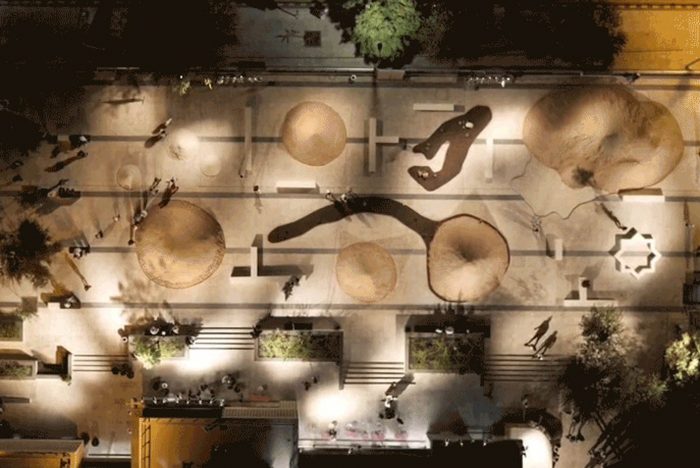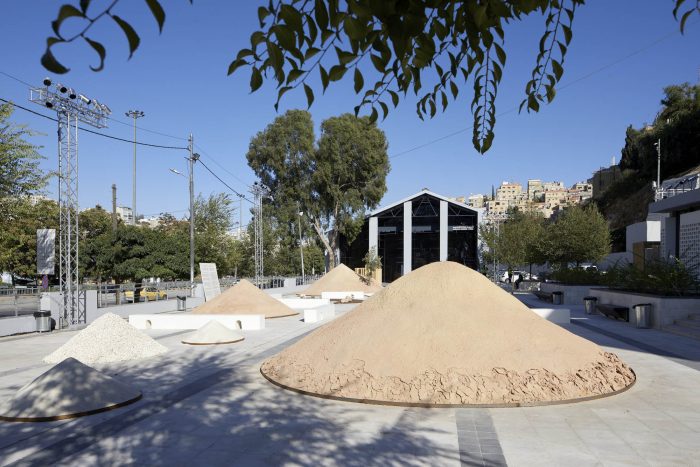在一个缺水或无法获得水的现实中,我们如何构思我们的公共空间?在一个干旱的时代,在一个文化背景下,我们如何重新想象一个花园的概念?
In a reality where water is short or inaccessible, how do we conceive of our public spaces? How do we re-imagine the idea of a garden in a time of drought and in a cultural context where the garden, in its abundance of water and lush vegetation, is in itself a manifestation of ‘Paradise’?
“小天堂 “旨在作为一系列针对阿拉伯天堂和殖民主义绿色概念的挑衅。地中海东部的阿拉伯国家把花园称为小天堂(jnaina):有界限的绿色盒子–在有序的构图中对植物进行精细的策划。在整个阿拉伯半岛,它们被称为hadayiq,意思是 “约束或包围”。
‘Minor Paradises’ is intended as a series of provocations set against the Arab Paradise and against colonial notions of green. The Arab countries of the eastern Mediterranean refer to gardens as little paradises (jnaina): bounded boxes of green- delicate curation of plants in an ordered composition. Across the Arabian Peninsula, they are referred to as hadayiq, meaning ‘to bound or encircle’.
在这种情况下,花园作为有界限的绿色空间在20世纪中期之前是很罕见的。传统的庭院往往是荒芜的–保留给洗衣、牲畜和烹饪。绿色作为一种室内幻想,只保留给那些能够负担得起用于美容或耕作的奢侈用水的人。今天,海湾地区的景观是一种继承的幻想:修剪整齐的草坪,青翠的后院–护理或丰饶的概念,都是借用的殖民主义的虚构。
In this context, the garden as bounded space of green was rare until the mid-20th century. Traditional courtyards were often barren – reserved for laundry, livestock and cooking. Greenery as an interior fantasy was reserved only for those who could afford the luxury of water that was spent on beauty or cultivation. Today the Gulf landscape is an inherited fantasy: the well mowed lawn, the verdant setback – notions of care or fecundity that are borrowed colonial fictions.
“小天堂 “重新审视了传统的庭院和风景如画的约旦景观的概念,并从领土的尺度上取样,将其重新解释为人类尺度上的微型景观。当地的沙子、砾石、火山岩和石灰石重新创造了景观,构建了地形和地势条件,并策划了游客的体验,连接回我们景观的核心元素。土丘被认为是一座山或者是一座丘陵。砾石块作为一个表面,或作为一个领土。
‘Minor Paradises’ revisits the traditional notion of the courtyard and the picturesque Jordanian landscape, and samples scenarios from the territorial scale re-interpreting it as a miniature landscape at human scale. Locally sourced sands, gravel, volcanic rock, and limestone re-create the landscape, construct topography and terrain conditions, and curate the visitor’s experience, connecting back to the core elements of our landscape. The mound is perceived as a mountain or as a hill. The gravel patch as a surface, or as a territory.
当地适应性极强的耐旱物种以集群的形式出现,协商一种新的、无水的美学的可能性。因此,这个花园暗示了另一种护理、维护和美容的概念。白色胶合板的长椅反映了阿拉伯世界中作为社会空间的庭院的类型。这些长椅允许互动,并向这个建筑景观展示了不同的观点。长椅上的小拱门进一步强调了装置的无尺度性质。
Local adapted species of extreme drought tolerance appear as clusters negotiating the possibility of a new, water-less aesthetic. The garden therefore suggests alternative notions of care, maintenance and beauty. The benches in white plywood reflect on the typology of the courtyard as a social space in the Arab world. The benches allow for interaction and expose different views towards this constructed landscape. Small arches in the benches further emphasize the scale-less nature of the installation.
“小天堂 “是 Civil Architecture和studiolibani(景观建筑+城市主义)之间的合作。’Minor Paradises’是一个全面的、为期一周的、720平方米(7750平方英尺)的公共花园装置,在2019年安曼设计周期间,在约旦安曼的艾因机库广场举行。以 “可能性 “为主题的2019安曼设计周机库展由Nora Al-Sayeh策划,Rana Beiruti指导。通过Anas Mikhi和团队实现了执行。
‘Minor Paradises’ is a collaboration between Civil Architecture and studiolibani (landscape architecture + urbanism). ‘Minor Paradises’ is a full-scale, week-long, 720 square meters (7750sq ft) public garden installation that took place in Amman, Jordan during Amman Design Week 2019, at the Al Ain Hangar Plaza. Amman Design Week 2019 Hangar Exhibition, themed “Possibilities” was curated by Nora Al-Sayeh and directed by Rana Beiruti. Execution made possible through Anas Mikhi and team.
Architects: Civil Architecture, studiolibani
Area: 720 m²
Year: 2019
Photographs: Edmund Sumner
Construction: Anas Mikhi
Lighting Design: Sosthen Hennekam
Landscape Designers:Dima Rachid, Leah Moukarzel Sarkissian
Model Making:Fatima Nickahdar
Curation Coordinator:Rana Beiruti
Curator:Noura Al Sayeh
City:Amman
Country:Jordan


















